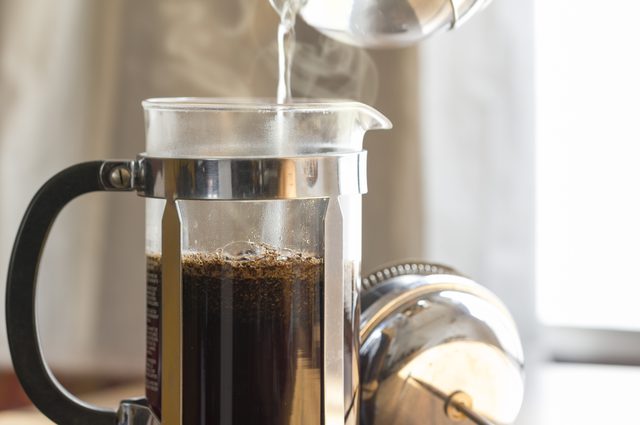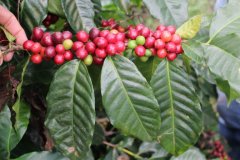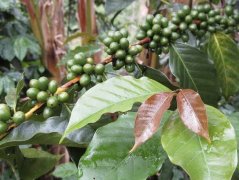The Development of Fine Coffee (scaa) A brief introduction to the concept and definition of Fine Coffee

Professional coffee knowledge exchange more coffee bean information please follow the coffee workshop (Wechat official account cafe_style)
In recent years, coffee drinkers have more or less heard the term "boutique coffee", but the editor can guarantee that even professional coffee practitioners will not be able to tell the definition of standard boutique coffee. It is not that the concept of boutique coffee is so ethereal, on the contrary, it is precisely because the concept of boutique coffee is still in its infancy and is being updated and perfected over time, which makes it difficult to remember.
The so-called boutique coffee refers to the coffee made from raw beans which are grown in a few ideal geographical conditions and have excellent taste characteristics. This kind of coffee beans will be strictly selected and graded, with hard texture, rich taste and excellent flavor. In order to maximize their flavor and flavor levels, bakers will bake them light and medium, while the previously popular heavy baking is falling out of favor.
Literally, many people may mistakenly think that Specialty refers to the high price of coffee, but in fact, it refers to exquisite coffee quality. "boutique coffee" is translated as "special coffee" according to Baidu. Is "special coffee"boutique coffee"?
Of course. No.
The earliest definition of "boutique coffee"
The term "boutique coffee Specialty Coffee" was first put forward in 1978 by Ms. Erna Knustsen, the godmother of boutique coffee, at the French Coffee International Conference, so "boutique coffee" has been widely used by the coffee industry.
Boutique Coffee Godmother-Erna Nusen (Erna Knutsen)
Simply looking at the most primitive definition of "boutique coffee", you may wonder: shouldn't it just be called specialty coffee? The coffee beans with unique flavor cultivated under special climate and geographical conditions should be called special coffee.
No, no.
At present, the more popular is the SCA (the name of the merger of the American Fine Coffee Association and the European Fine Coffee Association) to judge the fine coffee, mainly by judging whether it has rich aroma, acidity, mellow thickness, aftertaste, taste, taste balance and so on.
Before the merger, SCAE defined boutique coffee as "high standard selection of beans, superb baking and brewing techniques", focusing on the production process and expertise of coffee itself, while SCAA defined "from coffee farmers to baristas must have high standards of quality", focusing on industry standards and sense of mission. SCAJ is defined as "coffee that makes consumers willing to give a good evaluation on the basis of being satisfied with the excellent flavor", with more emphasis on the taste itself and consumer experience.
Coffee farmers: carefully select the most suitable varieties, planted in the altitude, climate and soil and water environment that are most conducive to the development of coffee flavor.
Raw bean merchants: careful washing and sun processing, select the most advanced raw beans without defects, and deliver them to customers with zero defects in the transportation process.
Baker: after the baker's superb craftsmanship, it leads to the richest flavor of the region.
Barista: and then use the recognized extraction method to make delicious coffee.
Consumers: pursue not only the highest standards of coffee quality and flavor, but also the excellence of each role in the boutique coffee production process.
Because of the coffee beans made in this way, the taste levels and aroma are more complex and changeable than matching beans, so the hand-flushing method arises at the historic moment. In this way, even the same kind of coffee beans will have different flavors according to the different stewing time, flow speed and water temperature, which can be said to adapt to the current trend of pursuing individualization. it can also better show the unique complexity of boutique coffee itself.
Fine coffee, should be 100% Arabica beans.
Definition of "boutique coffee" in other countries
European Fine Coffee Association SCAE:
Boutique coffee is [after consumers drink, give carefully carved high-quality coffee evaluation], this cup of coffee will have a unique quality and outstanding flavor, different from the general coffee available everywhere, European boutique coffee admits that the market supply of boutique coffee has its limitations, it does not belong to the coffee service that can be consumed everywhere, but with the highest standard of raw beans through superb baking technology. All raw beans and cooked beans adopt high-standard storage specifications, and then brew high-quality coffee with high-standard brewing technology.
SCAJ, Japan Fine Coffee Association
"Fine coffee is coffee that consumers drink with excellent flavor and are willing to give a good evaluation, and consumers are satisfied. The definition of excellent flavor is that the coffee flavor can leave an obvious impression, sour, bright, crisp and special. At the same time, the coffee has a sweet finish. Coffee itself must be able to implement consistent and strict production procedures, unified procedures and strict quality management at all stages from raw beans to a cup of coffee. Only coffee that meets the above conditions belongs to fine coffee.
"Fine Coffee"-- from seed to Cup
SCAJ focuses on "the flavor characteristics of the liquid in the cup", while the American Fine Coffee Association (SCAA) advocates that the object of evaluation should be "raw coffee beans". On the other hand, the European Fine Coffee Association (SCAE) advocates that the "coffee liquid" of the coffee base should be evaluated.
However, there is still a consensus among countries that several obstacles must be overcome in order to gain the title of "boutique coffee". One of the conditions is that traceability (Traceability) should be clear. That is, the "production resume" must be clear, which can track which coffee beans are produced in which country, which region and which coffee garden.
From the definition of boutique coffee by the three major boutique coffee associations in the world, we can find that fine coffee refers to all the processes from "one coffee seed to a cup of coffee". Only by taking good care of every link and understanding the source to the end can we understand "boutique coffee".
The elements of the third wave of boutique coffee
The third wave of coffee, that is, the concept of "boutique coffee", which pays attention to "from seed to cup", should be inherited into China by Taiwan and Japan at the earliest. Han Huaizong, a master of coffee in Taiwan, mentioned in "Fine Coffee." there are six elements in the third wave of boutique coffee:
1. Pay attention to the taste of region: discuss the taste of different regions with more specific producing areas, manors, latitudes, elevations, treatments, microclimates and varieties.
2, avoid heavy baking on light baking: reduce the degree of baking, to shallow baking, interpretation of fine beans bright and lively sour perfume fruit tone.
3. Pay attention to the treatment of low pollution: no longer stick to the dogma of giving priority to washing beans with water, improve it into a treatment method that does not require water consumption, expand the diversity of coffee flavor spectrum, protect the environment and sustainable management.
4. Filter black coffee has become the mainstream: promote the original black coffee without sugar and milk, and use follicular utensils to let the coffee speak on its own.
5. Direct baking plant of origin: replace the "fair trade" system with "direct transaction". Bakers go to various producing areas to find good beans to help farmers understand the quality requirements of the boutique market, and then improve the quality, so as to trade directly at a better price. Form a positive interaction between the producing area and the consumer country, and promote the relationship between upstream and downstream.
6. scientific interpretation of coffee aesthetics: regard coffee as an aesthetics, and attach importance to the scientific research of seed selection, cultivation, treatment, cup test, roasting, extraction, concentration and extraction rate.
In short, boutique coffee should be a high-quality coffee with "good raw beans, good roasting and good extraction".
To sum up
1. Fine coffee is made from boutique coffee beans. If the beans that make coffee are not boutique coffee beans, the coffee liquid produced cannot be called fine coffee.
two。 Boutique coffee is fresh coffee. Whether it's food or drink, of course, the fresh the better, and so is boutique coffee. High-quality coffee should keep the coffee beans fresh before making, including the preservation of baked beans, and grind the coffee beans into powder before making, which is also to retain its original and best flavor. The way of making hand-brewed coffee is such a way to make high-quality coffee, and it is also one of the coffee-making methods that can best retain the original flavor of coffee.
3. Boutique coffee is good coffee and is harmless to health. Different from coffee made with low-quality coffee beans, high-quality coffee uses high-quality coffee beans and freshly made coffee, which is harmless to health, and drinking in moderation is beneficial to the body and mind. (of course, do not overeat. I will explain to you the harm of excessive coffee consumption in the future.)
4. Boutique coffee has a rich and beautiful taste. Even if the coffee made of boutique coffee beans is not all fine coffee, it depends on whether it gives full play to the characteristics of coffee beans, whether it has a good taste, if not, it can not be called boutique coffee.
What is exciting is that more and more people are beginning to accept drinking drip-filtered coffee without sugar and milk to taste the pure flavor of the coffee beans themselves. I believe that under the advocacy of all the fans of the third wave of coffee, there will be more boutique coffee and boutique cafes in the Chinese market. More and more people will be able to taste the real taste of coffee and experience the wonderful feeling that coffee brings to us!
END
Important Notice :
前街咖啡 FrontStreet Coffee has moved to new addredd:
FrontStreet Coffee Address: 315,Donghua East Road,GuangZhou
Tel:020 38364473
- Prev

The difference between Colombian coffee and espresso. Can Colombian coffee beans be made Italian?
Professional coffee knowledge exchange more coffee bean information Please follow the coffee workshop (Wechat official account cafe_style) it's time for us to start new science popularization again. There must be a variety of coffee beans that are easy to encounter when buying coffee beans on the market, and that is Colombian coffee beans. Colombia is the third largest coffee producer in the world, with good quality and a long history, so it is naturally popular with coffee fans.
- Next

What are the producing areas of boutique coffee? the list of boutique coffee bean producing areas in 2019
Professional coffee knowledge exchange more coffee bean information please pay attention to the coffee workshop (Wechat official account cafe_style) which boutique coffee producing areas? We all know that fine coffee pays attention to from seeds to cups, and there are very strict requirements for the original ecology of the producing area and the picking and treatment of farmers, so not all coffee producing areas in the world can produce fine coffee. Of course, Jing.
Related
- Beginners will see the "Coffee pull flower" guide!
- What is the difference between ice blog purified milk and ordinary milk coffee?
- Why is the Philippines the largest producer of crops in Liberia?
- For coffee extraction, should the fine powder be retained?
- How does extracted espresso fill pressed powder? How much strength does it take to press the powder?
- How to make jasmine cold extract coffee? Is the jasmine + latte good?
- Will this little toy really make the coffee taste better? How does Lily Drip affect coffee extraction?
- Will the action of slapping the filter cup also affect coffee extraction?
- What's the difference between powder-to-water ratio and powder-to-liquid ratio?
- What is the Ethiopian local species? What does it have to do with Heirloom native species?

